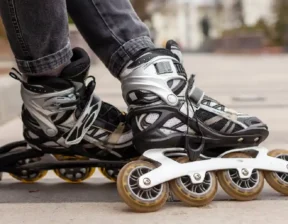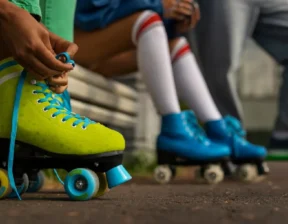
Extra 10% Off Orders above ₹2499 : Use Code: HUP10
Safest Comfort Helmet for Kids
Free Shipping | 7-Day Free Returns
Lifetime Warranty*
COD Available

by Basit Manzoor
Helmets are essential safety gear designed to protect our heads during various activities, including cycling, motorcycling, skiing, and more. While helmets are built to provide protection, they are not indestructible and have a limited lifespan. Understanding when helmets go bad is crucial to ensure their effectiveness in safeguarding us. In this comprehensive guide, we will look at the factors that affect helmet lifespan, signs of helmet deterioration, and when it’s time to replace your helmet.
Read More: Teach Child Bicycle Riding Techniques: A Parent’s Toolkit
Before discussing when helmets go bad, it’s important to understand their construction. Most helmets consist of a hard outer shell made of materials like polycarbonate, fibreglass, or carbon fibre, an impact-absorbing liner, and a retention system to keep the helmet in place. The liner, usually made of expanded polystyrene (EPS), is designed to absorb and dissipate impact forces.
Several factors influence the lifespan of a helmet. It’s important to consider these variables to determine when a helmet may start to degrade:
Frequent use exposes the helmet to wear and tear, reducing its overall lifespan. Regular activities subject the helmet to repeated impacts and environmental conditions that can deteriorate its integrity.
A significant impact can compromise a helmet’s ability to protect you. Even if no visible damage is present, the internal structure may be compromised, reducing its effectiveness in subsequent impacts.
Extended exposure to heat and sunlight can degrade helmet materials. UV rays can weaken the shell and fade the helmet’s colour, indicating a loss of structural integrity.
Storing your helmet inappropriately, such as leaving it in extreme temperatures or near chemicals, can accelerate deterioration.
Helmets have a recommended lifespan, usually around 3-5 years, provided by the manufacturer. Over time, the materials in a helmet may degrade, impacting its ability to protect you adequately.
While helmets can withstand significant use, they can deteriorate over time. Look out for the following signs that indicate your helmet may be going bad:
Cracks, dents, or deformations in the outer shell can compromise its structural integrity. Similarly, any damage to the liner should be taken seriously, as it reduces the helmet’s impact-absorbing capabilities.
The retention system, typically composed of straps and buckles, ensures the helmet stays securely on your head. If the system becomes loose, worn, or damaged, it may not provide the necessary stability during an impact.
Excessive exposure to sunlight can cause the helmet’s colour to fade. While this is primarily a cosmetic issue, it may indicate underlying material degradation.
Your helmet emits strange odours that may indicate bacterial growth or mould formation. This can occur due to sweat absorption and inadequate cleaning.
As mentioned earlier, helmets have a recommended lifespan. If your helmet is approaching or has exceeded this timeframe, it is likely time for a replacement.
Read More: How To Pick The Right Helmet for Your Kid?
Knowing when to replace your helmet is crucial for maintaining optimal safety. Consider the following guidelines:
Always follow the helmet manufacturer’s guidelines regarding lifespan and replacement. They have extensive product knowledge and conduct testing to determine the recommended lifespan.
If your helmet shows visible cracks, dents, or deformations, it is no longer safe for use and should be replaced immediately.
If your helmet experiences a significant impact, even if there is no visible damage, it is advisable to replace it. The impact may have compromised its internal structure, reducing its effectiveness in subsequent impacts.
If your helmet has reached or exceeded the manufacturer’s recommended lifespan, it’s time to invest in a new one. Even if it appears to be in good condition, the materials may have degraded over time, compromising its protective capabilities.
A helmet should fit comfortably and securely on your head. If the padding has worn out or the helmet no longer provides a snug fit, it’s time for a replacement.
Helmets are crucial for protecting our heads during various activities but have a limited lifespan. Regular use, impact severity, exposure to heat and sunlight, improper storage, and age are factors that affect helmet deterioration. By recognizing signs of helmet deterioration and following manufacturer recommendations, you can ensure your helmet provides optimal protection. Remember, when in doubt, it’s better to err on the side of caution and change your helmet to prioritize your safety.
If you’re looking for a safe, secure, and attractive Helmet for your kids, then Headzup is the right place for you. We have the best kids’ helmets for cycling and skating.
 8 June 2025
8 June 2025
Are you new to skating and just learning to slide on your skateboard? Whether you’re...
 7 June 2025
7 June 2025
Skateboarding is an art form, a lifestyle, and a sport. Maybe it’s even more than...
 6 June 2025
6 June 2025
Need a greener, eco-friendly, budget-friendly ride? Electric cycles are the solution for you. It offers...
 5 June 2025
5 June 2025
Imagine starting your bicycling journey feeling strong, focused, powerful, and injury-free. A proper warm-up does...
FIND WHAT MOVES YOU
FIND WHAT MOVES YOU
FIND WHAT MOVES YOU
FIND WHAT MOVES YOU
FIND WHAT MOVES YOU
FIND WHAT MOVES YOU